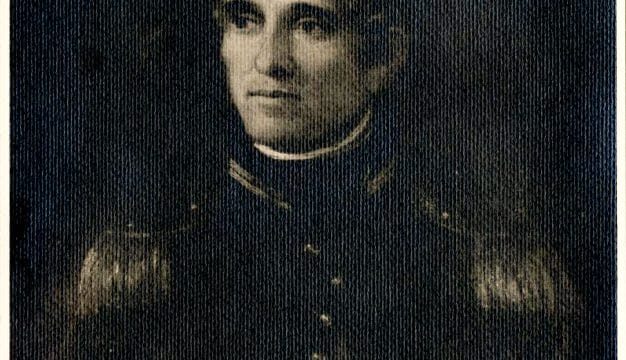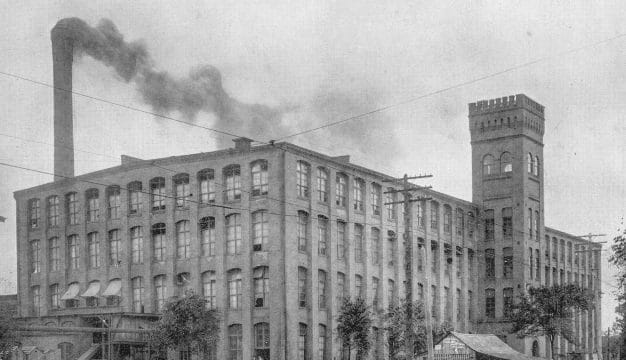University of South Alabama
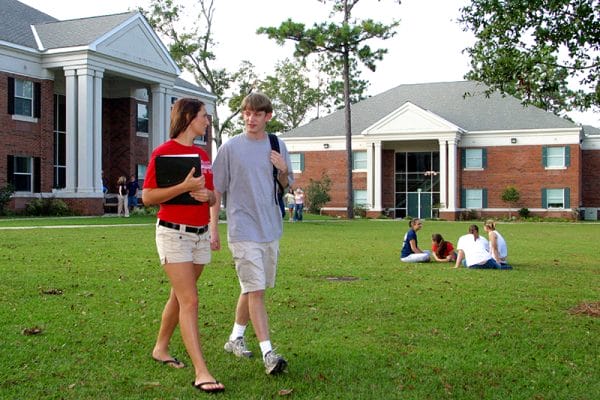 University of South Alabama
A former extension campus of the University of Alabama, the University of South Alabama (USA) was established in May 1963 and is now one of the largest universities on the Gulf Coast. The university is Mobile County‘s largest employer and boasts a student body of 14,000. During the past 45 years, the university has strengthened its community ties through historic preservation, medical research, sporting events, and outreach programs.
University of South Alabama
A former extension campus of the University of Alabama, the University of South Alabama (USA) was established in May 1963 and is now one of the largest universities on the Gulf Coast. The university is Mobile County‘s largest employer and boasts a student body of 14,000. During the past 45 years, the university has strengthened its community ties through historic preservation, medical research, sporting events, and outreach programs.
In 1944, the University of Alabama (UA) began offering extension courses in downtown Mobile in a small facility on St. Louis Street near Bienville Square. Students at the extension center could obtain associate degrees but had to travel to Tuscaloosa to participate in commencement ceremonies or take advanced courses. From 1944 until 1960, officials at the University of Alabama refused to offer advanced degrees or increase funding for the Mobile extension center. South Alabama residents thus had to travel to Tuscaloosa, which was more than 200 miles away.
In 1960, Frederick Palmer Whiddon, a native of Newville, in Henry County, and recent graduate of Emory University, became the director of the Mobile Extension Center. He had hoped to improve and expand the institution, but when his efforts were blocked by the administration in Tuscaloosa, Whiddon began the process of removing the extension center from the University of Alabama’s control. He joined with prominent Mobile businessmen to convince the Alabama legislature to create the Mobile County Foundation for Public Higher Education in February 1961 to encourage the development of a state-supported university in south Alabama.
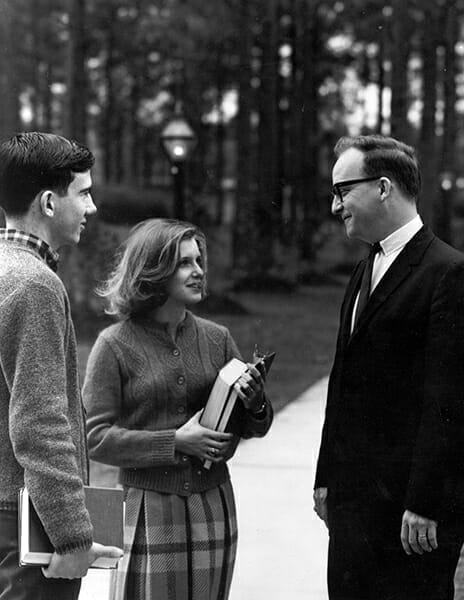 Frederick Whiddon and Students
After two years of negotiations between the University of Alabama and the Mobile delegation to the legislature, the University of South Alabama (USA) was chartered in May 1963 and Fred Whiddon named its first president. USA was the first public university chartered in Alabama since the University of Montevallo was established in 1896, almost 70 years earlier. At the time of its founding, USA was also a desegregated institution. George Wallace‘s support for the creation of USA came just weeks before he blocked the admission of Vivian Malone, an African American student from Mobile, from entering the University of Alabama. The USA board of trustees bought land in West Mobile and moved into its first new building in April 1964. The first freshman class at USA numbered 928 students, and they and the 34 full-time faculty members occupied a single building on the new campus originally designed to hold only 600 people. Plans for expansion were being finalized even before the facility was dedicated in October 1964. Four years later, USA was accredited by the Southern Association of Colleges and Schools.
Frederick Whiddon and Students
After two years of negotiations between the University of Alabama and the Mobile delegation to the legislature, the University of South Alabama (USA) was chartered in May 1963 and Fred Whiddon named its first president. USA was the first public university chartered in Alabama since the University of Montevallo was established in 1896, almost 70 years earlier. At the time of its founding, USA was also a desegregated institution. George Wallace‘s support for the creation of USA came just weeks before he blocked the admission of Vivian Malone, an African American student from Mobile, from entering the University of Alabama. The USA board of trustees bought land in West Mobile and moved into its first new building in April 1964. The first freshman class at USA numbered 928 students, and they and the 34 full-time faculty members occupied a single building on the new campus originally designed to hold only 600 people. Plans for expansion were being finalized even before the facility was dedicated in October 1964. Four years later, USA was accredited by the Southern Association of Colleges and Schools.
In March 1965, faculty members petitioned the Alabama legislature for an increase in the school’s annual appropriation. Their efforts were aided by Whiddon’s persistence with Mobile legislators, who increased the appropriation from $1 million to $4.2 million for 1965-1966, enabling construction plans for a cafeteria, a swimming pool, faculty offices, and a bookstore to move forward. The administration also secured several historic structures to enhance the appeal of the university to the people of Mobile. In 1965, the first historic structure relocated onto the campus was the Tuthill Townhouse, built in 1845, which was endangered by expansion of Interstate 10. Soon, two additional historic structures, the Seamen’s Bethel Chapel and the Toulmin House, joined the Tuthill Townhouse on the USA campus, linking Mobile’s rich architectural past to the new university. In 1970, the university acquired the historic Saenger Theatre in downtown Mobile and opened a theatre department. The first play in the renovated theatre was William Shakespeare’s “A Midsummer Night’s Dream.”
 University of South Alabama Under Construction, 1963
As the new university continued to grow, state and national officials began to take notice. In 1965, Whiddon was named one of America’s Ten Outstanding Young Men by Look magazine and the United States Junior Chamber of Commerce. At 35, Whiddon was the youngest university president in the nation. In June 1967, USA held its first graduation ceremony. The following year, USA received accreditation from the Southern Association of Colleges and Schools, signaling that the university staff, structures, and curricula met the organization’s standards and that degrees from the university were valid. This accreditation represented a final approval of the university and set the stage for further expansions in programs and facilities.
University of South Alabama Under Construction, 1963
As the new university continued to grow, state and national officials began to take notice. In 1965, Whiddon was named one of America’s Ten Outstanding Young Men by Look magazine and the United States Junior Chamber of Commerce. At 35, Whiddon was the youngest university president in the nation. In June 1967, USA held its first graduation ceremony. The following year, USA received accreditation from the Southern Association of Colleges and Schools, signaling that the university staff, structures, and curricula met the organization’s standards and that degrees from the university were valid. This accreditation represented a final approval of the university and set the stage for further expansions in programs and facilities.
The first major expansion of the campus came in 1969, when the university acquired Brookley Field, a former U.S. Army air base near downtown Mobile. The 327-acre facility closed in 1964, devastating Mobile’s economy, but the expanding university offset some of the resulting job and revenue losses and became the city’s largest employer. The university moved several departments to the Brookley Campus and renovated its cafeteria and officer’s lounge into meeting rooms for conventions and other functions.
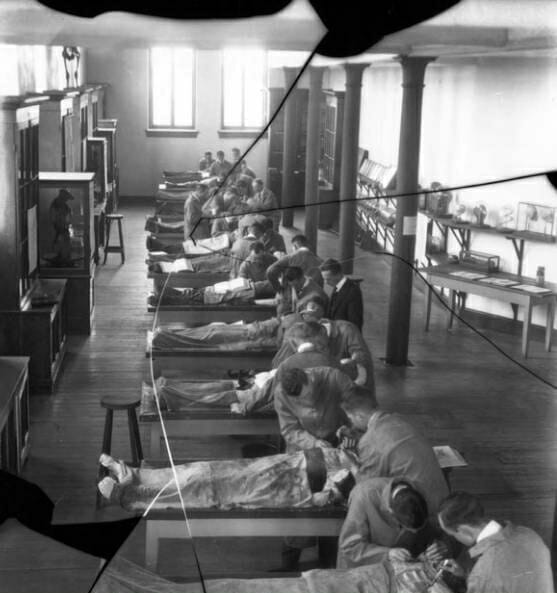 Mobile Medical College Students
Following the Brookley Campus expansion, Whiddon and the board of trustees began working to establish a university medical school that would revive the tradition of the Mobile Medical College, which served the area from 1859 to 1920 and was one of the preeminent medical schools in Alabama. These plans were approved by the Alabama legislature on August 9, 1969. The prospect of another medical school in the state outraged University of Alabama officials, who had invested a great deal of money and effort in a large medical school in Birmingham (as part of the University of Alabama at Birmingham). Despite these objections, Mobile residents welcomed the return of a medical college to the area. The Mobile city and county commissions allocated $4.5 million for the college and in November 1970 transferred ownership of the old Mobile General Hospital to the university, which turned the facility into a teaching hospital for nurses and physicians.
Mobile Medical College Students
Following the Brookley Campus expansion, Whiddon and the board of trustees began working to establish a university medical school that would revive the tradition of the Mobile Medical College, which served the area from 1859 to 1920 and was one of the preeminent medical schools in Alabama. These plans were approved by the Alabama legislature on August 9, 1969. The prospect of another medical school in the state outraged University of Alabama officials, who had invested a great deal of money and effort in a large medical school in Birmingham (as part of the University of Alabama at Birmingham). Despite these objections, Mobile residents welcomed the return of a medical college to the area. The Mobile city and county commissions allocated $4.5 million for the college and in November 1970 transferred ownership of the old Mobile General Hospital to the university, which turned the facility into a teaching hospital for nurses and physicians.
By 1971, the university had finalized plans for three additional medical buildings, including a separate College of Nursing. The Alabama legislature approved the expansion and allocated another $10 million to the project. These actions continued to draw criticism from officials at the University of Alabama at Birmingham and the Birmingham News, which questioned the wisdom of maintaining two medical schools in the cash-strapped state. President Whiddon and physician Robert M. Bucher, the first dean of the College of Medicine, dismissed these objections, citing the critical shortage of physicians in Alabama as proof that Alabama needed another medical school. In January 1973, the 25 members of the initial class of the University of South Alabama College of Medicine began their coursework, and medical education returned to Mobile after a 50-year absence, representing a historic achievement for the still-young university.
In 1978, officials established the University of South Alabama Archives to house the photographic collection of Mobile photographer Erik Overbey, and it has since grown to become one of the largest archives of images and manuscript material in the region. The archives, combined with the historic structures relocated onto campus and the renovations of the Saenger Theatre and Brookley Complex, linked USA to the rich history and culture of Mobile.
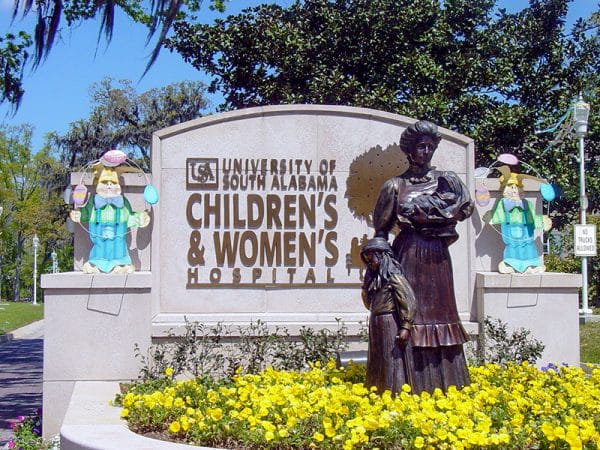 University of South Alabama Children’s and Women’s Hospital
Expansion of the USA campus continued in the 1980s, when the university purchased the former Providence Hospital from the Daughters of Charity and moved the College of Nursing into the historic facility. Renamed the Springhill Avenue Campus, the expansive 550,000-square-foot building more than doubled the amount of space available to the university. The Springhill Avenue Campus housed the College of Allied Health. A family-practice clinic staffed by USA medical school staff and students occupied a 7,000-square-foot facility on the first floor and provided care to 13,000 patients in its first year of operation. In 1989, the university archives relocated to the Springhill Campus as well. The archives was renamed the Doy Leale McCall Rare Book and Manuscript Library in May 2011.
University of South Alabama Children’s and Women’s Hospital
Expansion of the USA campus continued in the 1980s, when the university purchased the former Providence Hospital from the Daughters of Charity and moved the College of Nursing into the historic facility. Renamed the Springhill Avenue Campus, the expansive 550,000-square-foot building more than doubled the amount of space available to the university. The Springhill Avenue Campus housed the College of Allied Health. A family-practice clinic staffed by USA medical school staff and students occupied a 7,000-square-foot facility on the first floor and provided care to 13,000 patients in its first year of operation. In 1989, the university archives relocated to the Springhill Campus as well. The archives was renamed the Doy Leale McCall Rare Book and Manuscript Library in May 2011.
During the late 1980s and early 1990s, the University of South Alabama continued to expand, purchasing additional land and buildings. The university established the Children’s and Women’s Hospital, acquired Doctors Hospital and Knollwood Park Hospital, and increased its course offerings in Baldwin County with an extension campus in Fairhope. USA also added master’s level programs in most disciplines as well as doctoral programs in instructional design and medically related biological sciences. The university established a joint doctoral program in pharmacy with the Harrison School of Pharmacy at Auburn University. Nearby Dauphin Island Sea Lab became the host site for a doctoral program in marine science.
Throughout this time, the university and its fund-raising arm, the University of South Alabama Foundation, grew under President Whiddon’s direction. The foundation purchased extensive amounts of timber acreage, a move that generated some controversy at the time. Conflict between Whiddon and the USA board escalated in 1998, leading to Whiddon’s resignation, which was conditional on his retaining his seat as head of the USA Foundation for several more years. He was succeeded as president by V. Gordon Moulton, a long-time administrator at USA.
In 1999, several members of the USA Foundation and board of trustees filed suit to have Whiddon removed from his position as head of the foundation. An agreement was reached in 2001 that allowed Whiddon to retire from the board, which he did because of failing health in early 2002. He died on May 1, 2002, and is remembered as the founder of one of the fastest-growing universities in Alabama history. Named in his honor, the USA administration building contains a life-sized statue of Whiddon dressed in academic regalia, which greets visitors with a smile and outstretched hand.
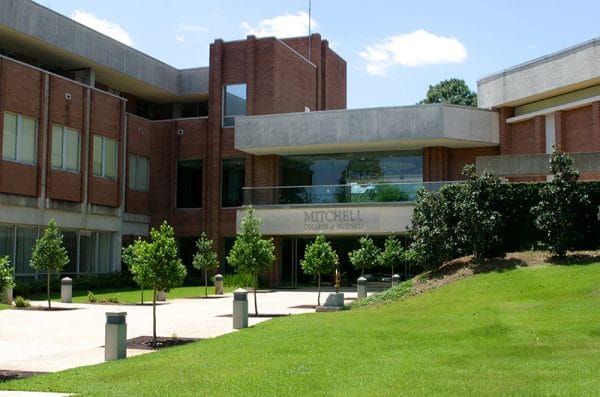 Mitchell College of Business
Since its founding in 1963, the University of South Alabama has made a significant impact on the educational climate in south Alabama. USA has built an expansive 1,200-acre campus in west Mobile that features state-of-the-art technology and is home to the Mitchell College of Business, named for the families of Mayer and Arlene Mitchell. The Mitchells have donated more than $36.6 million to USA, including a $22 million gift to USA’s cancer research institute, a $125 million research and treatment facility that opened in 2008. In 1992, the university established the Center for Archaeological Studies, which promotes research and oversees archaeological excavations in the region; in 2012, the center added the 8,000-square-foot Archaeology Museum, which highlights various periods in Gulf Coast’s prehistory and history.
Mitchell College of Business
Since its founding in 1963, the University of South Alabama has made a significant impact on the educational climate in south Alabama. USA has built an expansive 1,200-acre campus in west Mobile that features state-of-the-art technology and is home to the Mitchell College of Business, named for the families of Mayer and Arlene Mitchell. The Mitchells have donated more than $36.6 million to USA, including a $22 million gift to USA’s cancer research institute, a $125 million research and treatment facility that opened in 2008. In 1992, the university established the Center for Archaeological Studies, which promotes research and oversees archaeological excavations in the region; in 2012, the center added the 8,000-square-foot Archaeology Museum, which highlights various periods in Gulf Coast’s prehistory and history.
 USA Archaeology Museum
Sports have been significant at USA for many decades. In 1972, the university’s baseball team was ranked number 1 in the country. They were led to 36 wins that season by veteran coach, and former Brooklyn Dodger, Eddie Stanky. The South Alabama Jaguars basketball team was a charter member of the Sun Belt Conference in 1976. In December 2007, the USA Board of Trustees voted to include Division 1-A football by 2009, a decision welcomed by students and area boosters. University of Alabama standout and Mobile native Joey Jones was named the first head football coach of the Jaguars. Throughout the year, fans can be seen at university sporting events wearing the school colors: red, white, and blue. The university opened Hancock Whitney Stadium in 2020. The USA medical system treats 250,000 patients each year at its hospitals and clinics. The university continues to be a major economic driver in the Mobile area, employing thousands of people and having an estimated $3 billion impact on the local economy. Approximately 85 percent of Mobile’s K-12 teachers receive training and degrees from USA, and one in three physicians in south Alabama have been trained at a USA hospital. Recent expansion plans include the addition of a research and technology park, a new student services building, a recreational center, a health services building, and the expansion of the Mitchell Cancer Institute. In 2020, the Fanny Meisler Level 1 Trauma Center at University Hospital opened. These improvements ensure that the University of South Alabama will remain a force in Alabama higher education for decades to come.
USA Archaeology Museum
Sports have been significant at USA for many decades. In 1972, the university’s baseball team was ranked number 1 in the country. They were led to 36 wins that season by veteran coach, and former Brooklyn Dodger, Eddie Stanky. The South Alabama Jaguars basketball team was a charter member of the Sun Belt Conference in 1976. In December 2007, the USA Board of Trustees voted to include Division 1-A football by 2009, a decision welcomed by students and area boosters. University of Alabama standout and Mobile native Joey Jones was named the first head football coach of the Jaguars. Throughout the year, fans can be seen at university sporting events wearing the school colors: red, white, and blue. The university opened Hancock Whitney Stadium in 2020. The USA medical system treats 250,000 patients each year at its hospitals and clinics. The university continues to be a major economic driver in the Mobile area, employing thousands of people and having an estimated $3 billion impact on the local economy. Approximately 85 percent of Mobile’s K-12 teachers receive training and degrees from USA, and one in three physicians in south Alabama have been trained at a USA hospital. Recent expansion plans include the addition of a research and technology park, a new student services building, a recreational center, a health services building, and the expansion of the Mitchell Cancer Institute. In 2020, the Fanny Meisler Level 1 Trauma Center at University Hospital opened. These improvements ensure that the University of South Alabama will remain a force in Alabama higher education for decades to come.
Further Reading
- Caldwell, James F. Magic—No! Miracle—Yes!: The Founding and Early Development of the University of South Alabama. Mobile, Ala.: n.p., 1998.
- University of South Alabama Collections, The Doy Leale McCall Rare Book and Manuscript Library, Mobile, Alabama.
